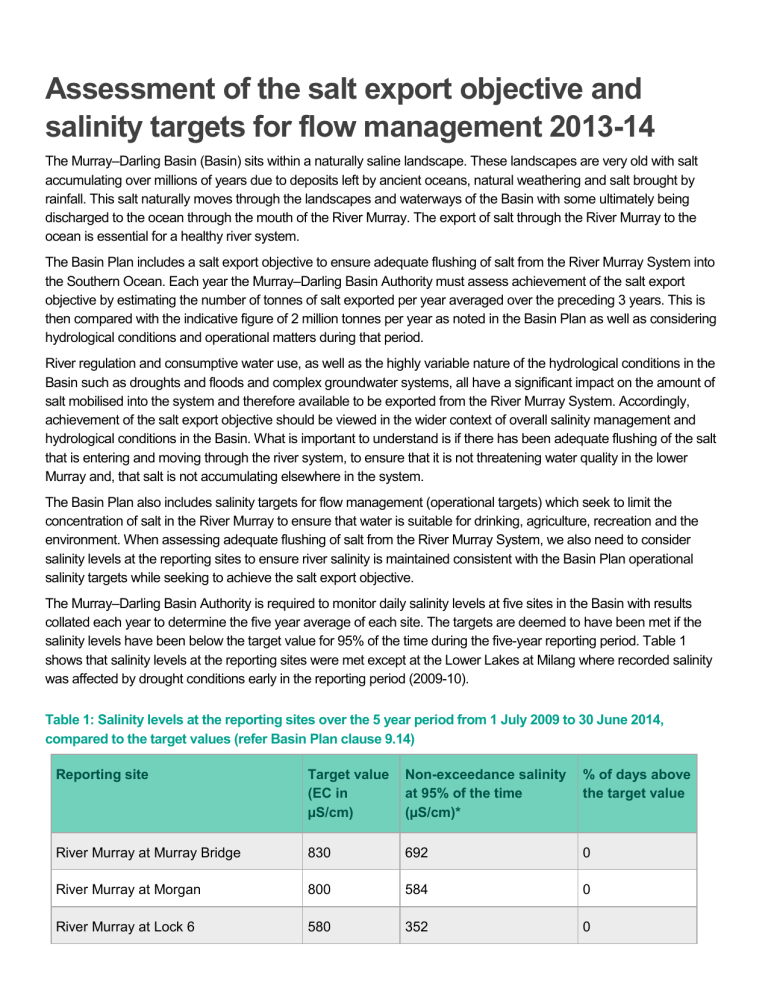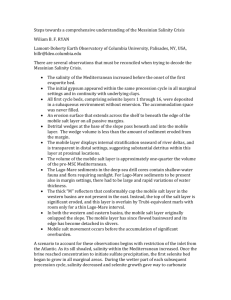Assessment of the salt export objective and salinity targets for flow

Assessment of the salt export objective and salinity targets for flow management 2013-14
The Murray –Darling Basin (Basin) sits within a naturally saline landscape. These landscapes are very old with salt accumulating over millions of years due to deposits left by ancient oceans, natural weathering and salt brought by rainfall. This salt naturally moves through the landscapes and waterways of the Basin with some ultimately being discharged to the ocean through the mouth of the River Murray. The export of salt through the River Murray to the ocean is essential for a healthy river system.
The Basin Plan includes a salt export objective to ensure adequate flushing of salt from the River Murray System into the Southern Ocean. Each year the Murray –Darling Basin Authority must assess achievement of the salt export objective by estimating the number of tonnes of salt exported per year averaged over the preceding 3 years. This is then compared with the indicative figure of 2 million tonnes per year as noted in the Basin Plan as well as considering hydrological conditions and operational matters during that period.
River regulation and consumptive water use, as well as the highly variable nature of the hydrological conditions in the
Basin such as droughts and floods and complex groundwater systems, all have a significant impact on the amount of salt mobilised into the system and therefore available to be exported from the River Murray System. Accordingly, achievement of the salt export objective should be viewed in the wider context of overall salinity management and hydrological conditions in the Basin. What is important to understand is if there has been adequate flushing of the salt that is entering and moving through the river system, to ensure that it is not threatening water quality in the lower
Murray and, that salt is not accumulating elsewhere in the system.
The Basin Plan also includes salinity targets for flow management (operational targets) which seek to limit the concentration of salt in the River Murray to ensure that water is suitable for drinking, agriculture, recreation and the environment. When assessing adequate flushing of salt from the River Murray System, we also need to consider salinity levels at the reporting sites to ensure river salinity is maintained consistent with the Basin Plan operational salinity targets while seeking to achieve the salt export objective.
The Murray
–Darling Basin Authority is required to monitor daily salinity levels at five sites in the Basin with results collated each year to determine the five year average of each site. The targets are deemed to have been met if the salinity levels have been below the target value for 95% of the time during the five-year reporting period. Table 1 shows that salinity levels at the reporting sites were met except at the Lower Lakes at Milang where recorded salinity was affected by drought conditions early in the reporting period (2009-10).
Table 1: Salinity levels at the reporting sites over the 5 year period from 1 July 2009 to 30 June 2014, compared to the target values (refer Basin Plan clause 9.14)
Reporting site Target value
(EC in
µS/cm)
Non-exceedance salinity at 95% of the time
(µS/cm)*
% of days above the target value
River Murray at Murray Bridge
River Murray at Morgan
River Murray at Lock 6
830
800
580
692
584
352
0
0
0
Reporting site Target value
(EC in
µS/cm)
Non-exceedance salinity at 95% of the time
(µS/cm)*
% of days above the target value
Darling River downstream of Menindee
Lakes at Burtundy
830 611 0.2
Lower Lakes at Milang 1,000 4,786 30
*Salinity levels compiled from best available data (daily mean values derived from continuously logged data).
EC is an electrical conductivity unit commonly used to indicate salt concentration or the salinity of water
Figure 1: Salt loads at key locations in the Murray –Darling Basin
Salinity at Milang increased markedly during the extended drought due to the low inflows and the effects of high rates of evaporation. In October 2010, water levels returned to normal in Lake Alexandrina resulting in decreased salinity levels at Milang. During 2013-14, salinity at Milang was about 757 EC for 95% of the time and did not exceed the target at any time.
The salt loads shown in Figure 1 demonstrate the movement of salt throughout the River Murray System. A provisional 1 salt export estimate indicates that the annualised rate of salt export over the three year period (2011-
1 At the time of estimating salt export, 2013-14 diversion data from South Australia was not available.
2014) was 1.5 million tonnes (Table 2). This is less than the Basin Plan indicative figure of 2 million tonnes.
A range of factors can influence how much salt is exported each year. For example, during extended drought and periods of below average inflows into the River Murray System, flows may not be adequate to flush 2 million tonnes of salt while maintaining salt concentration in the river at acceptable levels. It is during these periods where protection of the river system from salt accessions is more important than exporting salt out to the ocean. Salt interception schemes, built over the past three decades to protect the shared water resources in the river, have an important role to play during these times in diverting salt away from the River Murray. In 2013-14, 398,000 tonnes of salt was diverted away from the River Murray through salt interception schemes. During periods of higher flow, salt interception schemes play less of a role in reducing river salinity as there is greater dilution due to the higher flows.
Although salt export over the reporting period (2011-2014) has been less than the 2 million tonnes, maintenance of flows over the barrages into the Coorong, and low salinity levels in the lower Murray has meant that some level of flushing has occurred providing evidence of adequate flushing. However, despite flushing occurring, some salt may have accumulated in the lower Murray during the reporting period.www.mdba.gov.au
Table 2: Summary of locations and salinity measurement variables used in the assessment of the salt export objective
Variable 2011-12 2012-13 2013-14
Darling River at Burtundy salt load (tonnes/yr) 0.6 million
River Murray at Euston salt load (tonnes/yr)
River Murray at Lock 6 salt load (tonnes/yr)
0.7 million
1.3 million
River Murray at Morgan salt load (tonnes/yr) 1.6 million
River Murray at Murray Bridge salt load (tonnes/yr) 1.8 million
Salt diverted away from the river through salt interception schemes (tonnes/yr)
0.363 million
Estimated salt export at the barrages (tonnes/yr)
–
3 year average is 2.0 million tonnes per year
2.2 million
Annual average salinity (salt concentration) of
Lake Alexandrina (EC – electrical conductivity)
434 EC
0.4 million
0.5 million
0.9 million
1.1 million
1.2 million
0.323 million
1.4 million
460 EC
0.07 million
0.2 million
0.3 million
0.5 million
0.6 million
0.398 million
1.5 million
676 EC
Flow over the barrages 8,794 GL 5,267 GL 1,784 GL







